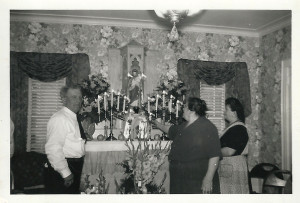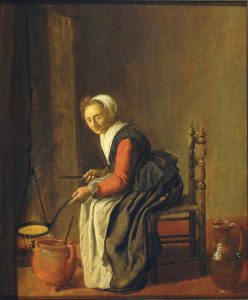In which the author contemplates the ancient recipes of a region of Southern Italy, the contents of the pockets of Stephen Foster, the days of Holy Week, and the moon that journeys with us this night.
We are in the midst of Holy Week, the most complex of celebrations in the Christian calendar. We have been for a few days now. It began with Palm Sunday, and I have a confession to make: Palm Sunday is not one of my favorite days. Father Seamus likes to say that attendance at St. Bernard’s always increases for Palm Sunday. “People come when we give things away at Mass,” he says, but give me all the palms you want… I still have never been fond of the day and of the reading of the Passion of the Lord. The congregation has its parts to read and it always feels a little lackluster to me, half-hearted. I’m also never sure what the proper mood is supposed to be on Palm Sunday. Celebration? Mourning? And then––and this is a rather bizarre thing, I know––I just do not like the word “Hosannah,” and it comes up a lot on Palm Sunday, especially in the newer songs.
And so I tend to avoid Palm Sunday Mass. Tonight, however, is Holy Thursday, or Maundy Thursday. And with Maundy Thursday, we get to one of my favorite nights. It begins with Mass, and here it is a trilingual affair in English, Spanish, and Creole, bringing the entire congregation together. Each year I recognize people I see just this one night each year. It is my one chance each year to sing in Creole. Sometimes––last year no but this year perhaps––it is a Creole song that just happens to be set to the tune of Stephen Foster’s “My Old Kentucky Home,” and I love that. I sit there amongst these people that I know in this once-a-year fashion, like the old Creole woman who reminds me of my grandmother, and I think of Grandma and also Grandpa and all the ones I love who have come and gone, and I think of Stephen Foster, who died with a slip of paper in his pocket on which he had written the words “Dear friends and gentle hearts,” and I inhale the incense and the ritual I have known for as long as I can remember and I let it wash over me and it is nothing at all like Palm Sunday. It is quite certain that this is a night for contemplation, and I am secure in that state.
The tradition is to visit two more churches once Mass is done on Maundy Thursday, for a total of three. Some folks go for seven, but like the seven fishes we Italians eat on Christmas Eve, seven is an awful lot of one thing. Grandma was content with three churches and so am I. The moon is always big and bright and it follows me along on my journey, which usually takes me from Lake Worth to West Palm Beach and then over across the lagoon to Palm Beach and then back home again. It is a full night. At each church, I sit in the quiet stillness, usually me and a few other souls. Even in the churches that are not mine I recognize a few people I see but once a year, on this night. At St. Edward’s, which is on Palm Beach and looks a bit like the Vatican, which is not what we’re accustomed to on this side of the lagoon, it’s always the woman near the front row with a veil of black lace over her head.
My mother tells a story of my grandmother Assunta at work in the kitchen, making the taralli for Easter, on one Maundy Thursday, when Nardine Uzzi, who probably was called Cummara Nardine, because everyone was a cummara in those days, came by and said, in their broken English dialect from Lucera, “Come on Assu, facime i sepulica!” That is, “Come on, Assu, let’s get to the churches!” But Grandma protested that she couldn’t go; she had to finish making the taralli. And so Nardine said, “Ok, we make them together subito subito” (fast fast) and so they did and then off they went to visit the three churches: St. Blaise, St. Francis, and Holy Cross. Sometimes Cummara Catherine would go, too, and then they would stop at the chocolate shop to buy chocolate bunnies for Easter.
I never even met some of these people and yet they are some of the people I think of as I make my rounds and sit in those dark churches as the moon follows along. Earlier in the day, on the Maundy Thursdays that go well, I’ll get to help out my mom and my sister with some of the traditional baking for Easter. There are the braids of sweet dough that Grandma Cutrone used to make for all of us grandkids, there are the Humpty Dumpties that I’ve been decorating since I was a little boy, and there are the taralli. They are a sort of pretzel, traditional to my family’s part of Italy, Apulia. Grandma would make them for Easter and for Christmas and sometimes for no reason whatsoever, but always for Easter. They are central to the Easter table. And perhaps you would like to make them, too. If you do, it’s good to have someone to share the labor with, just like Assunta and Cummara Nardine. This way you finish subito subito, and then you’re done with it, giving you more time to enjoy the fruits of your labor, together with friends and family. Don’t forget the wine. Bread and wine, pane e vino: taralli pair perfectly with a good Italian red wine. This is as it’s been for my people since time immemorial. In remembrance of everyone.
T A R A L L I
3 cups flour
2 cups semolina
1 teaspoon baking powder
1 teaspoon salt
1/2 cup olive oil
1 1/4 cups warm water
anise or fennel seeds
Preheat oven to 360 degrees F. Mix the dry ingredients together, then add the olive oil and water and a liberal amount of your choice of anise or fennel seeds. You can work by hand or use a mixer to make into a nice dough. Let the dough rest 15 minutes. Next, shape by rolling pieces of dough into ropes and twisting into the shapes you see in the photograph above (rings, twists). Have a large kettle of salted water boiling on the stove. Drop the shaped taralli into the boiling water, a few at a time. As they rise to the surface, remove them with a strainer. Place them on an oven rack and once the rack is full of boiled taralli, place the rack in the oven and bake until golden brown and crisp.


